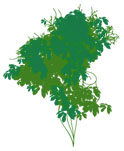#02 A Partnership With Nature
Several years ago, we were challenged by a stream of ants! They would pass over the threshold of the door of our two kitchens, which were connected with a one step elevation. Very often it would happen that somebody would just stand in the doorway to chat and would get attacked by ants, after all, we were invading their space and were stepping on them. But they were in our house, so there had to be a solution to this challenge.
So how did we manage to resolve the issue, and at the same time retain the ants?
We got down on our knees, analyzed a potential alternative route for the ants to take, made a mental path with our finger along the bottom of the threshold as opposed to over, and then we asked them with intent, to ‘start using that way’ as soon as possible.
Low and behold, the next day, we could stand in the doorway, and the ants were busy with their daily activity, with a slight detour. The ants followed our request and it did not even seem to mind them!
Another useful partnership example is when ants clean up our leftover food. Whenever we need to have an empty bag of sugar, milk carton or flour sack cleaned, we do not rinse it, but instead, leave it out on a spot that we know is frequented by ants, and in wink of an eye the ants do all the work for us, ready to recycle!
Before we built our new house in Lipa, we studied the land and it’s surroundings to get a better insight as to what we were planning for the future. Permaculture is a great tool to analyze landscapes, contour lines, water flow and the biological life, uniting all components into a holistic picture.
The biggest challenge that we noticed right away was the amount of termites eating away at all the old wood and at the ants climbing on us and giving us enough acid zaps to dance to.
Permaculture sees solutions and not the problems. And if there are any good indicators of a fast turnover of biomass into fertilizer they are the termites, ants and fungi. After all, both the termites and ants collect appropriate lignin sources that they incubate in fungi grow-rooms underground to later be used for their new offspring as food.
At our forest that surrounds us, we find all kinds of mushrooms of which we have identified four types that we can eat. The one in the picture is the Pleurotus pulmonarius or the lung oyster mushroom, which has medical applications such as anti-inflammation and a cure for hay fever, besides being very tasty. They pop-out of the wood, which is shaded by ferns and trees to provide a feast, nature is just abundantly giving.
Our house was built on pillar stilts to make our lives a bit easier coping with the termites and we placed a water lock around each post to keep the ants at bay. What also helps to keep turmites away is to clean up around, removing all dead wood since these are termite attractors due to the high emission of CO2 –carbon dioxide- released during fungal decomposition.
Besides that, we planted a lot of turmeric around as old folk tales shared that it too could help. ‘No harm in that’, we thought – after all, turmeric is an amazing health source and a potential income from the dried root that is ground to a powder!
Once we take the time to deeply interact with where we are, we might be amazed what kinds of connections we can make with and in nature. After all it is in continuous motion, a vibration and a pulse. In this time and age of knowledge we need to awaken the wisdom of nature in our own nature and utilize it, work with it and create oneness.







